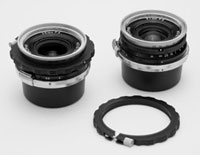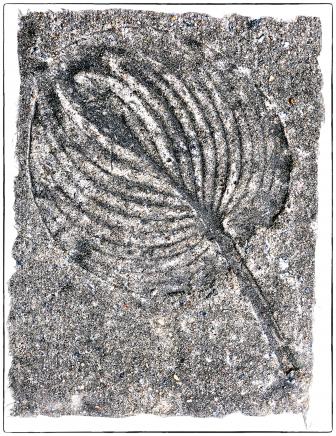New Voigtlander Lenses
Adapt To Fit Rangefinders, Old And New
Nikon's brief reintroduction of the rangefinder S3 in a "millennium commemorative" edition prompted the issue of three Voigtlander lenses in Nikon fit: the 21mm f/4, 25mm f/4, and 35mm f/2.5. Few "new" S3 Nikons will ever be used in anger, and many of these Voigtlander lenses will be bought to round out an outfit that goes straight onto a shelf: the Nikon, after all, comes only with the standard 5cm f/1.4 lens. But for those who do want to use their rangefinder Nikons (ancient or modern), or Contaxes, or indeed Kievs, these new lenses are a blessing. Before going on to look at the new lenses, which are essentially remounted versions of lenses that have already been reviewed (in Leica screwmount) in Shutterbug, it is worth looking at the cameras that they will fit, and at other lens choices for these cameras, which are few in number but legendary in status. Without understanding this, one cannot put the new lenses in context. Mountable Cameras: Contax |
|||
A lot of Zeiss lenses were made for Contaxes both prewar and postwar, but few still look good today: in the days before coating, Zeiss preferred contrasty but not very sharp lenses, where Leicas had sharper but less contrasty lenses. Postwar, from Oberkochen (the seat of Zeiss was of course Jena) the original 21mm f/4.5 Biogon was and is a superb lens, but it's pretty rare; the 25mm f/4 Topogon is even rarer (I had one, once, the only one I've ever seen); and the postwar 35mm f/2.8 Opton with the small rear element is much rarer than the prewar (and significantly inferior) 35mm f/2.8 Biogon. There is a 35mm f/3.5 Planar, which is reputedly excellent but I have never seen one, and a 35mm f/2.8 Biometer, though these were only ex-Jena. The 50mm and longer postwar lenses are pretty good, but not up to the standard of modern lenses. The Kiev |
|||
Nikon Rangefinders Unlike the Kiev, which basically was a prewar Contax (albeit with occasional updates such as flash synchronization), the Nikons borrowed from a number of other sources, including a Leica-style shutter, which is longer lived and faster moving than the old roll-top desk. Today, unfortunately, Nikkors for the old rangefinders are only a little more common than hens' teeth, though the 21mm f/4 was stunning and the others were very good for their day. The quality of Nikon lenses made the company's name, especially during the Korean war when several American correspondents bought Nikon outfits. The Common Mount |
|||
Standard lenses are fitted via a tiny internal bayonet mount, while all other lenses fit on a much larger external bayonet: the rangefinder coupling is accomplished by threading the throw of the focusing mount so that it matches the rotation of the focusing mount of the standard lens. In order to engage the lug on the lens with the socket in the focusing mount, the lens must be set at infinity when fitting or removing it, as must the lens mount on the camera. Otherwise, the instruction leaflet warns, "the lens may be difficult to remove from camera resulting in damage€not covered by the product guarantee." Because of the excessively complex mounts, and the relatively tiny size of the market, there have been few "independent" lenses in this fitting: Steinheil, Stewartry, one or two others, none particularly distinguished until now. There was once another Voigtlander lens in a Contax mount, the 50mm f/1.5 Nokton, but that was only a prototype, and besides, Voigtlander was owned by Zeiss at the time, having been taken over in 1956. Zeiss themselves seem not to have coupled the 21mm f/4.5 Biogon; I don't know if the 21mm f/4 Nikkor was coupled; and the 25mm f/4 Snapshot-Skopar doesn't couple to the Bessa series, so it was a surprise that all three of the new lenses are fully rangefinder coupled. There is an enduring question mark over how similar the focus register and rangefinder coupling are between Contax (and therefore Kiev) and Nikon-and it also helps to explain why the fastest lens supplied is the 35mm f/2.5. It looks as if the 35mm f/1.7 could be made to fit (the rear lens cell is well under 30mm in diameter, and would therefore go through the 36mm lens throat) but it might not couple adequately. The instruction leaflet (common to all three lenses) says, "if [the lenses are] used with conventional Contax models, no trouble is expected as possible error is within the depth of field." The Fit And Focus Test Finders & Filter Thread Filters on all three are 43mm, but all have twin, concentric female threads around the lens, the outer being 48mm for the vestigial lens shades supplied with the lens: 4mm deep for the 21mm, 6mm for the 25mm and 35mm. An unexpected accessory, packed with each lens, is a clamp-on focusing collar for those who find the body-mounted focusing knob hard to deal with; this includes the vast majority of people I have ever met who have tried to use a Contax or Contax derivative. All the lenses, of course, rotate in the mount, so all have twin aperture scales, 180ž apart, to ensure that at least one is adequately visible most of the time. All stop down to f/22, though by this point, diffraction limitations have knocked quite a lot off optimum definition. To sum up, what does this mean for the user? Well, for very rich users, it's easy: it means they can buy a new S3 and use that. The only camera I would rather have than the S3 in this fitting is an SP (which has a vastly superior viewfinder), and even then, given the choice between a new S3 and a 40-year-old SP, the S3 might win. For die-hard users of old cameras, it's also easy: you can, for the first time in almost four decades, buy new, state of the art lenses for your classic Contax, Nikon, or (if it's in good order) Kiev. And that has to be good news. Voigtlander cameras and lenses are imported by Schneider Optics Inc., 285 Oser Ave., Hauppauge, NY 11788; (631) 761-5000; fax: (631) 761-5090; www.schneideroptics.com. |





































